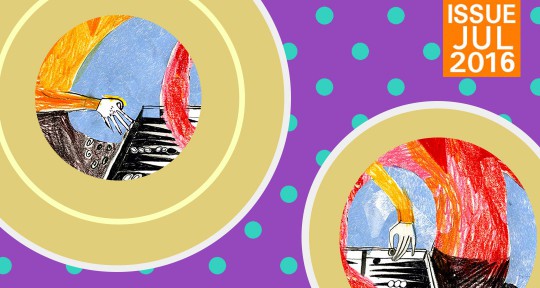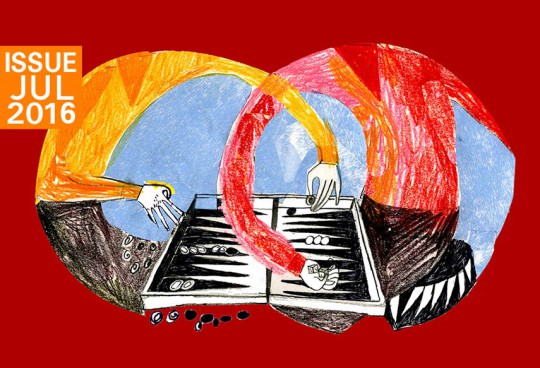After our first mention in The New York Times in June 2015 (which merely notes that there is a real-life counterpart to the journal by the name of “Asymptote” in Alena Smith’s drama), April 2016 sees our second mention and two key members stepping down. The departure of Senior Editor Florian—a friend from my time at The New School whose support has been a great source of strength for me, personally—is a great setback. But April 2016 also ushers in our first-ever monthly report, a two-page summary of each month’s activities which I’ll make available to the public for the first time here. Designed by Theophilus Kwek to be easily skimmed, this internal report not only records Asymptote‘s progress across the board each month, but also represents my commitment to transparency of the magazine’s financials. After all, as any serious dieter knows, tracking stats that matter is the way to go. A quick glance reveals that we spent $1,798 (all figures in USD) in total over April, while only $247 has come in through small donations and the sale of one publicity package. This means that over the month of April, Asymptote has bled $1,551 (which I cover either with funds previously raised or out of my own pocket). For the first three monthly reports (i.e., from April to June 2016), these figures do not yet include wages for Asymptote‘s only full-time team member (i.e., me). It is only in July 2016, exactly six years after I conceived the journal and opened a tab in my name that would add up to 70,000 USD while also foregoing a full-time salary all these years, that I begin to stipulate my own remuneration. This obviously doesn’t change the fact that monthly incoming funds are still a trickle compared to monthly outgoing funds, but at least it sets up a proper accounting as to how much I am being owed by my own organization. Here to introduce our Summer 2016 issue—possibly our most diverse ever, with 34 countries being represented and featuring additional translations into Albanian, Bengali, Chinese, Czech, Dutch, French, Greek, Japanese, Kannada, Korean, Persian, Portuguese, Slovak, and Tamil—is Assistant Editor Andreea Scridon.
What are our human perceptions made of? Water. Our nervous systems, the machineries of feeling, float in a quiet, dark world of water. Our most dramatic moments—at least in terms of development—take place in amniotic fluid. This quasi-godlike and continuous source of life is a trope that never runs dry. Yet in addition to its undeniable positive qualities, it makes for an inevitable metaphor for inner turmoil: after all, doesn’t turbulence stem from an aquatic scenario? The idea of fluidity, increasingly present in a contemporary world with an unstable future, further complicates things.
On the subject of “in-between times”, after finishing university a friend described herself as feeling as though she’d been soaked and left out in the sun to dry. Yet for a good writer (the kind I’d like to be), anxieties of this sort can acquire a kaleidoscopic quality on the page. How do we anchor ourselves to the world? How can we get past a feeling of being shipwrecked among the intensity of our selves? Can we even psychologically approach that which seems beyond our conception and our control? Finding myself too drenched by such ruminations to draw any conclusions, I turned to the varied readings of Asymptote’s Summer 2016 Issue.
Take, for instance, Pedro Novoa’s “The Dive,” translated into English by George Henson (and made available in 14 more languages). Form aptly mirrors content as the fluidity of the water that serves as the central environment is mimicked by the fluidity of a prose where neither past nor present dominate, with sensations edging out temporal concerns. This dominance of the piece’s atmospheric element stands in contrast to the concreteness of the medical solution which threatens to alter the narrative, but even sickness is ungraspable in its fluidity as the narrator notices underwater “bits of our life floating like irregular oil spots.” In fact, this pollution opposes purer images of “agonizing light,” of “the search for oysters and pearls.” This otherworldly and frightening undercurrent is dominated by children who fall prey to malevolent forces far beyond their conception and control and who, in their most dramatic moments, are nevertheless capable of anchoring themselves to their own perceptions.
Elsewhere in the issue, Ratik Asokan reviews Gabriela Adameșteanu’s The Encounter, translated by Alistair Ian Blyth. In this novel, modern society is curiously akin to an alien world in its unknowability. Living under the supervision of the Romanian communist secret police instills a deeply-ingrained sense of paranoia and spurs a desperate desire to awaken from the nightmare that is forcefully inflicted history. I include the premise of this “nuanced exploration of interiority”, as Asokan puts it, in my water musings as a parallel to Roberto Merino’s “Television, The Thousand One Nights,” translated by Neil Davidson. In the fictional and not-fictional twentieth century shared by both texts, the soft and sweet matter of the human brain is subjected to the hard metals of communism and television, and we have inherited this aquarium to live in, somewhere between God and reality shows. What’s more, urban space becomes nothing more than a temporal anchor as Merino describes the filtered lacks and gaps of memory via television as an “extended sojourn on the fringes of unreality.” I have long been preoccupied with the idea of unmooring, or feeling adrift among the depths of our most complex emotions and experiences.
On this topic of angst, I point to the multilingual writing feature of this issue because the transitional and oppositional space of translation is not without its anxieties. The creational act, which seeks to obtain harmony within discord, takes on a psychedelic nuance in MARGENTO’s translation of Serban Foarță’s “Buttérflyçion.” With this poem, Foarță surmounts formal anxieties by breaking the bounds of writing. This delightful oddity of a work unites amorphous verse (it’s worth hearing the thumping metre in MARGENTO’s delectable reading) with an amorphous author. Foarță, I learned, could be described as the lovechild of Tristan Tzara and Nasreddin Hodja. This parabolic trickster is also the creator of an utterly specific aesthetic as the songwriter for Phoenix, a Romanian rock band that was instrumental in ushering in post-communist liberty. Breaking the boundaries of conventional literary creation can be problem-solving: we become able to accept the paradoxes that come with feeling by freeing ourselves from linguistic constraints. Hemingway’s affirmation of “I write to bleed” echoes a tendency that comes up again and again the body of this issue, especially in this poem which defies classical notions of restraint.
Another discovery in fluidity was Raúl Gómez Jattin’s “AS IF YOU’D remember Isabel,” in James Rumsey-Merlan and Camila Vélez Valencia’s translation. The poet is a flagellator of memories, examining the curiosities of the mnemonic phenomenon that impel it towards it own self-denial: memory that is at some times so selective, and at other moments sears vividly. This reflects the whirlpool of inner turmoil, in which perception is magnified: he writes, or better said, sings, of “golden eyes like peacock feathers,” “of the hopscotch underneath your patio’s mamoncillo tree.” Gómez Jattin is a self-possessed wizard who manipulates the fluid phenomenon of memory: from “the rag dolls that were our children,” a flux occurs, and we find ourselves in other waters as the narrator declares that “my children are made of rag and my dreams are made of rag,” A final transition from idyllic childhood to crepuscular adulthood is made in the last line with his nihilistic response to Isabel’s asking about his life: “As if I had one of those.” This monumental link between childhood and nonexistence suggests that the rhyming nature of “womb” and “tomb” is a singular coincidence.
While circling my angst like a rabid rabbit this past summer, I found myself in this particular dune of the Asymptote archive and wandered out of it with the impression that…perhaps any feeling that has worth inherently has its oppositions, too. In such scenarios, writing itself becomes a solution for those of us prone to existential crises: we re-encounter fluidity on the page, turning to writing as a sense of perception. This is what the constantly re-emerging, multipartite character of Asymptote continues to mean for me—an array of senses, a variegated way of understanding my experiences and those very different from mine.
Andreea Scridon has been an Assistant Editor since July 2018.
Read more from our #30issues30days showcase:


